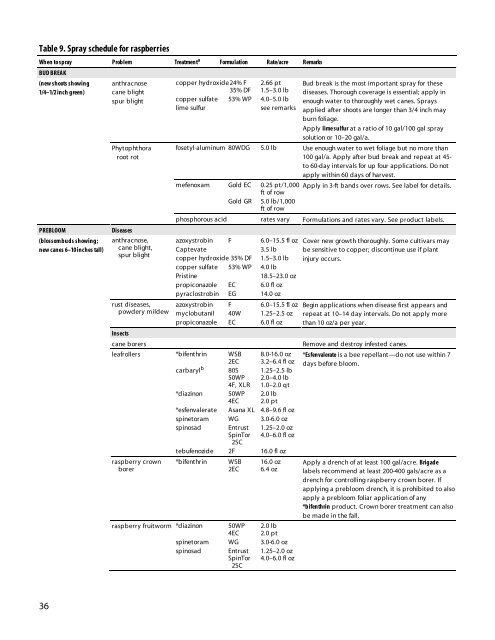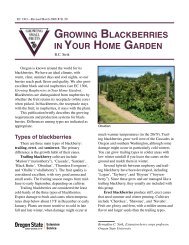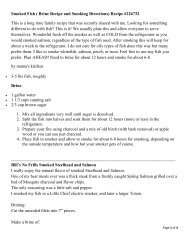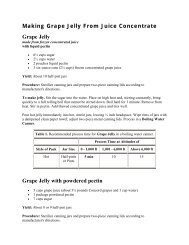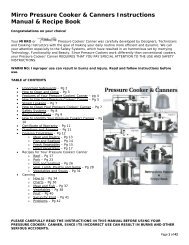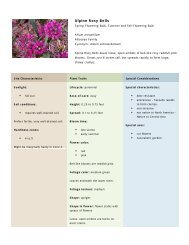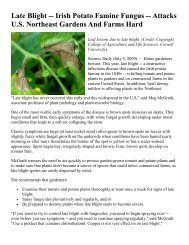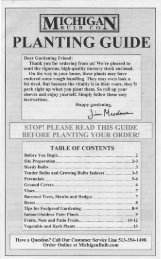Strawberry and Raspberry Pest Management in Wisconsin
Strawberry and Raspberry Pest Management in Wisconsin
Strawberry and Raspberry Pest Management in Wisconsin
You also want an ePaper? Increase the reach of your titles
YUMPU automatically turns print PDFs into web optimized ePapers that Google loves.
Table 9. Spray schedule for raspberries<br />
When to spray Problem Treatment a Formulation Rate/acre Remarks<br />
BUD BREAK<br />
(new shoots show<strong>in</strong>g<br />
1/4–1/2 <strong>in</strong>ch green)<br />
36<br />
anthracnose<br />
cane blight<br />
spur blight<br />
Phytophthora<br />
root rot<br />
PREBLOOM Diseases<br />
(blossom buds show<strong>in</strong>g;<br />
new canes 6–10 <strong>in</strong>ches tall)<br />
anthracnose,<br />
cane blight,<br />
spur blight<br />
rust diseases,<br />
powdery mildew<br />
Insects<br />
copper hydroxide 24% F 2.66 pt<br />
35% DF 1.5–3.0 lb<br />
copper sulfate 53% WP 4.0–5.0 lb<br />
lime sulfur see remarks<br />
Bud break is the most important spray for these<br />
diseases. Thorough coverage is essential; apply <strong>in</strong><br />
enough water to thoroughly wet canes. Sprays<br />
applied after shoots are longer than 3/4 <strong>in</strong>ch may<br />
burn foliage.<br />
Apply lime sulfur at a ratio of 10 gal/100 gal spray<br />
solution or 10–20 gal/a.<br />
fosetyl-alum<strong>in</strong>um 80WDG 5.0 lb Use enough water to wet foliage but no more than<br />
100 gal/a. Apply after bud break <strong>and</strong> repeat at 45-<br />
to 60-day <strong>in</strong>tervals for up four applications. Do not<br />
apply with<strong>in</strong> 60 days of harvest.<br />
mefenoxam Gold EC 0.25 pt/1,000<br />
ft of row<br />
Gold GR 5.0 lb/1,000<br />
ft of row<br />
Apply <strong>in</strong> 3-ft b<strong>and</strong>s over rows. See label for details.<br />
phosphorous acid rates vary Formulations <strong>and</strong> rates vary. See product labels.<br />
azoxystrob<strong>in</strong> F 6.0–15.5 fl oz<br />
Captevate 3.5 lb<br />
copper hydroxide 35% DF 1.5–3.0 lb<br />
copper sulfate 53% WP 4.0 lb<br />
Prist<strong>in</strong>e 18.5–23.0 oz<br />
propiconazole EC 6.0 fl oz<br />
pyraclostrob<strong>in</strong> EG 14.0 oz<br />
azoxystrob<strong>in</strong> F 6.0–15.5 fl oz<br />
myclobutanil 40W 1.25–2.5 oz<br />
propiconazole EC 6.0 fl oz<br />
Cover new growth thoroughly. Some cultivars may<br />
be sensitive to copper; discont<strong>in</strong>ue use if plant<br />
<strong>in</strong>jury occurs.<br />
Beg<strong>in</strong> applications when disease first appears <strong>and</strong><br />
repeat at 10–14 day <strong>in</strong>tervals. Do not apply more<br />
than 10 oz/a per year.<br />
cane borers Remove <strong>and</strong> destroy <strong>in</strong>fested canes.<br />
leafrollers *bifenthr<strong>in</strong> WSB 8.0-16.0 oz<br />
2EC 3.2–6.4 fl oz<br />
carbaryl b 80S 1.25–2.5 lb<br />
50WP 2.0–4.0 lb<br />
4F, XLR 1.0–2.0 qt<br />
*diaz<strong>in</strong>on 50WP 2.0 lb<br />
4EC 2.0 pt<br />
*esfenvalerate Asana XL 4.8–9.6 fl oz<br />
sp<strong>in</strong>etoram WG 3.0-6.0 oz<br />
sp<strong>in</strong>osad Entrust 1.25–2.0 oz<br />
Sp<strong>in</strong>Tor 4.0–6.0 fl oz<br />
2SC<br />
tebufenozide 2F 16.0 fl oz<br />
raspberry crown<br />
borer<br />
*bifenthr<strong>in</strong> WSB 16.0 oz<br />
2EC 6.4 oz<br />
raspberry fruitworm *diaz<strong>in</strong>on 50WP 2.0 lb<br />
4EC 2.0 pt<br />
sp<strong>in</strong>etoram WG 3.0-6.0 oz<br />
sp<strong>in</strong>osad Entrust 1.25–2.0 oz<br />
Sp<strong>in</strong>Tor 4.0–6.0 fl oz<br />
2SC<br />
*Esfenvalerate is a bee repellant—do not use with<strong>in</strong> 7<br />
days before bloom.<br />
Apply a drench of at least 100 gal/acre. Brigade<br />
labels recommend at least 200-400 gals/acre as a<br />
drench for controll<strong>in</strong>g raspberry crown borer. If<br />
apply<strong>in</strong>g a prebloom drench, it is prohibited to also<br />
apply a prebloom foliar application of any<br />
*bifenthr<strong>in</strong> product. Crown borer treatment can also<br />
be made <strong>in</strong> the fall.


